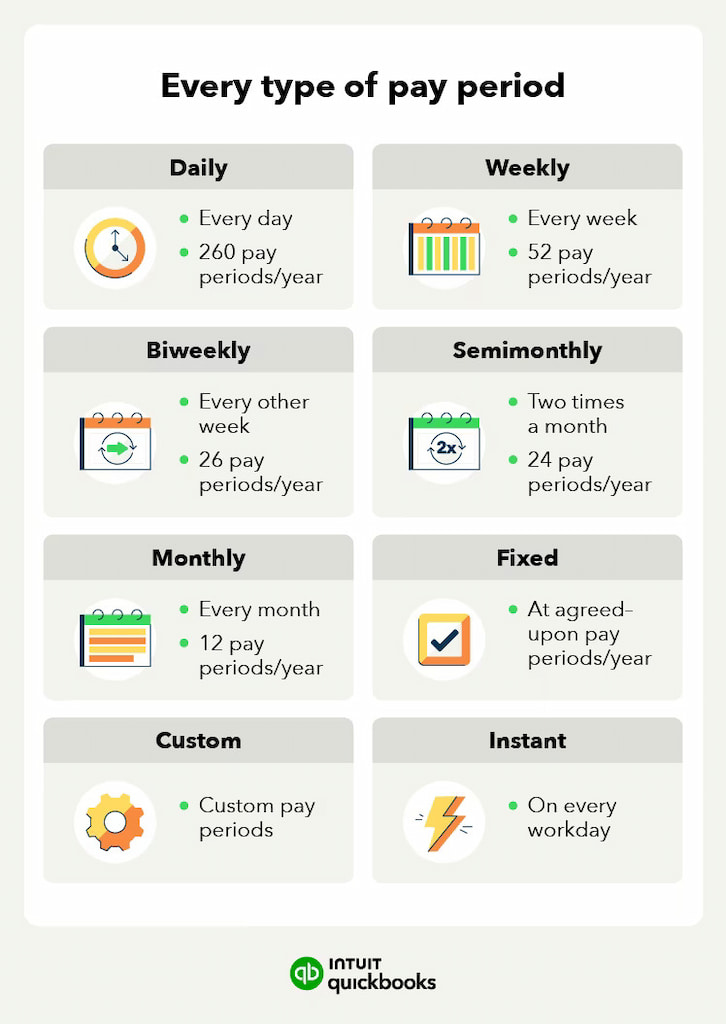Do you ever find yourself wondering how many pay periods in a year? Or maybe you’re curious about the number of pay weeks in a year, especially if you’re on a biweekly schedule like many of us.
In this article, we’ll explore everything from the typical number of paychecks in a year to the total payroll weeks in a year. So let’s take a closer look at paychecks and weeks in a year payroll calendars—it’s simpler than you think!
Defining Pay Periods: Key Concepts and Importance
A pay period is the recurring schedule your employer follows to compensate you for your work.
Think of it as a calendar specifically designed for your earnings. It dictates not only how often you receive your paycheck (including a final paycheck) but also plays a crucial role in how your annual salary or wages are broken down.
How Many Pay Periods in a Year?
The number of pay periods you have depends on how often you’re paid. If you’re on a weekly schedule, you’ll usually get 52 paychecks a year. A bi-weekly schedule means 26, while a semi-monthly schedule results in 24.
Knowing your pay period is essential for budgeting. It helps you understand how many paychecks to expect and plan your spending accordingly. Whether it’s weekly, bi-weekly, or semi-monthly, it sets the pace for your financial routine.
Different Types of Payroll Weeks in a Year
Different types of payroll weeks in a year
Understanding your pay schedule isn’t just about knowing when to expect a paycheck—it’s also a key piece in mastering your budgeting and planning. Here’s how different payroll types shape your year:
How many paydays in a year if I’m paid weekly? 🗓️
If you’re on a weekly pay schedule, you’re in luck! You get paid every single week, meaning you’ll have 52 paydays throughout the year. It’s a great setup for anyone who likes to track and manage weekly expenses. Plus, no waiting around for that paycheck to come through—it’s always right around the corner!
How many pays in a year when paid monthly? 💼
With a monthly pay schedule, you’ll see your paycheck come through once a month—so you’re looking at 12 paychecks a year. This might sound fewer, but it can actually make budgeting simpler if you like to plan in big chunks. Just remember, each paycheck needs to stretch a bit further, so budgeting becomes a skill you’ll quickly master!

How many paychecks in a year are paid semi-monthly? 💳
If you’re on a semi-monthly pay schedule, you’ll see two paydays each month, which adds up to 24 paychecks per year. It’s different from bi-weekly pay, because the number of weeks in the year doesn’t affect how many paychecks you get—just two each month, period. It’s a stable rhythm, which helps you keep track of expenses without worrying about calendar quirks.
How many paychecks in a year when there’s an extra week? 🎉
Sometimes, the calendar throws in a bonus! Normally, bi-weekly pay results in 26 paychecks per year, but in certain years, you could get an extra paycheck, bringing the total to 27. This happens because a year’s 52 weeks don’t fit perfectly into a bi-weekly cycle, and sometimes an extra period sneaks in.
When this happens, it can feel like finding an unexpected windfall—perfect for extra savings or tackling some debt. Just keep in mind that this only happens about once every 11 years. And if you’re wondering how your employer handles the extra paycheck, check in with HR to see if they adjust your tax withholdings or give you the full extra check.
The impact of periods in a year on tax deductions 💵
Your pay schedule can affect the tax deductions you see. For example, if you’re paid bi-weekly, each paycheck might have slightly more tax withheld compared to a monthly paycheck. This can impact your overall budgeting, so it’s important to be aware of how your pay period affects your take-home pay throughout the year.
Navigating how many pay weeks in a year during employment changes 🔄
Switching jobs often means switching pay schedules. If you move from monthly pay to bi-weekly pay, your paychecks will come more frequently, but each one might be smaller. Planning for this change is key to maintaining financial stability during transitions, so be sure to adjust your budget accordingly.
Legal requirements for how many paydays in a year ⚖️
How often you’re paid is also governed by state laws. These laws set minimum or maximum intervals between paydays to ensure fair compensation. It’s important for both employees and employers to understand these regulations so that everything stays legal and transparent.
Number of paychecks in a year with overtime ⏳
When you’re calculating overtime pay, your pay period affects how you track those earnings. On a weekly schedule, overtime is calculated each week, while with bi-weekly pay, overtime is typically tracked across two weeks. Knowing your schedule helps you ensure you’re tracking overtime accurately, and getting paid for every extra hour you work.
How Do I Choose How Many Pay Cycles in a Year for My Business?
Choosing how many pays in a year to use in your business can be a balancing act between administrative convenience and employee preference. When considering how many paychecks are in a year for each type of pay schedule, remember that certain years can add an extra payday.
As we established above, in a bi-weekly system, most years will have 26 paydays. But roughly every 11 years, there’s a leap year effect for those paid bi-weekly, resulting in 27 paydays. This means if you get paid every two weeks, how many paychecks in a year you receive can vary. In these years, your budgeting might need to accommodate this extra payday.
For weekly pay schedules, this effect is less pronounced, but it’s still there. The number of paychecks in a year can vary slightly due to how the dates fall. Similarly, monthly and semi-monthly schedules typically maintain a consistent number of paychecks in a year.

When deciding what’s best for your business, consider the stability and predictability of your cash flow. Monthly and semi-monthly schedules offer a predictable number of paydays, while weekly and bi-weekly can fluctuate slightly from year to year.
Comparison of How Many Pay Periods in a Year Across Industries
How many weeks in a year for payroll is not always the same in different industries. For example, if you work in retail, you might be paid bi-weekly, while government jobs often have monthly pay schedules. Healthcare positions might even pay weekly. Each industry tailors its pay schedule to meet its operational needs and standards. Here’s an example of how it typically works in different sectors:
| Industry | Pay period |
|---|---|
| Retail | Bi-weekly |
| Government | Monthly |
| Healthcare | Weekly |
| Technology | Bi-monthly |
| Education | Semi-monthly |
| Hospitality | Bi-weekly or monthly |
| Manufacturing | Weekly or bi-weekly |
| Finance | Bi-monthly or monthly |
| Construction | Weekly or bi-weekly |
| Non-profit | Monthly |
Advantages and Disadvantages of Different Pay Schedules
Each type of pay period has its ups and downs. Bi-weekly payments might offer a good mix of regular income and easy payroll management, but monthly payments can make it simpler to budget, even though they require more careful financial planning. It’s important to know how much pay in a year you will get, no matter how often you get paid.
Bi-weekly payments
✅ Pros: Regular income, easy payroll management.
❌ Cons: Budgeting challenges, 26 pay periods per year.
Monthly payments
✅ Pros: Simpler budgeting, and fewer payroll processes.
❌ Cons: Irregular cash flow, longer wait between paychecks.
Weekly payments
✅ Pros: Quick access to funds, easier budgeting.
❌ Cons: Administrative burden, 52 pay periods per year.
Semi-monthly payments
✅ Pros: Consistency, twice-monthly paychecks.
❌ Cons: Budgeting challenges, 24 pay periods per year.
Understanding the advantages and disadvantages of each pay period is crucial for effective financial planning, regardless of the frequency of payment.
How Many Pay Periods In a Year: FAQ
❓ Selecting a pay day: are there restrictions on which day?
You can choose any day to start your pay period, but consistency is key to ensure regular payroll processing and employee expectations.
❓ Understanding the difference between pay periods and pay dates
A pay period is the time span for which employees work and are paid, while a pay date is when employees receive their paychecks.
❓ Can I re-arrange my company’s pay period during the year?
Yes, but it requires careful planning and clear communication with employees. Ensure compliance with payroll and legal requirements.
❓ Is it okay to use varied pay schedules for different employees?
Different pay schedules can complicate payroll management. Consistency is generally recommended for simplicity.
❓ Effective ways to monitor employee pay schedules
Use payroll software to track pay periods, automate calculations, and ensure compliance with regulations.
Conclusion
In summary, mastering pay periods is key for both businesses and their teams. Our time tracker tool is designed to simplify this process. It accurately tracks working hours and adapts to various pay schedules, ensuring reliable and efficient payroll management. Explore how our tracker can be a game-changer in handling your payroll needs.
As one of the best time tracking software tools, Everhour goes beyond being just a time tracker. If you are managing a team of 5 or more and looking to boost efficiency, Everhour is the perfect tool to keep your team on track. With seamless time tracking, you can easily estimate task durations, set clear budgets, and generate detailed reports inside Asana, Trello, Jira, or any other pm tool.
Learn how to align payroll, budgets, and client billing without spreadsheets—and simplify your entire workflow today.

